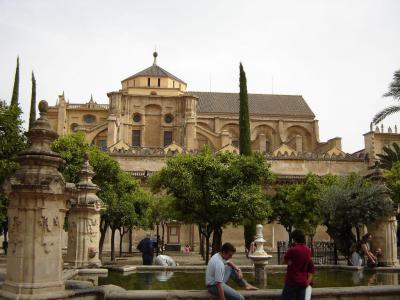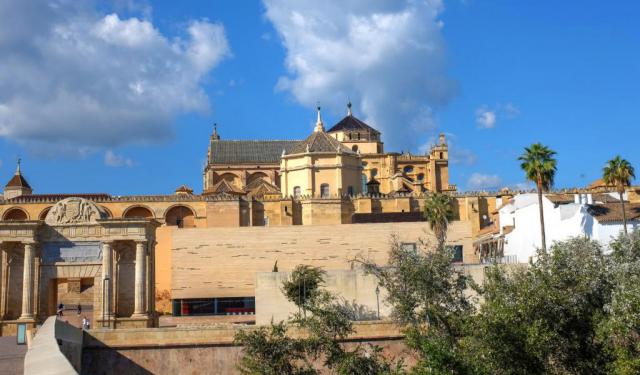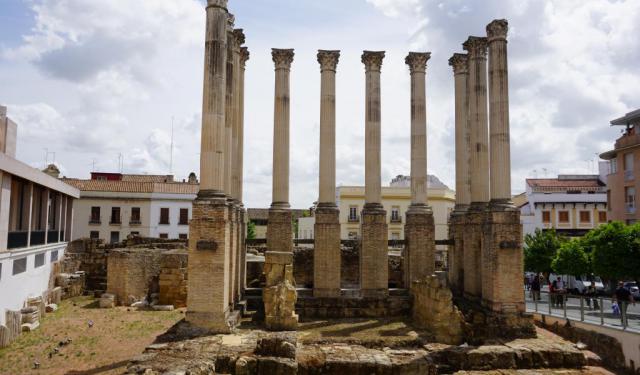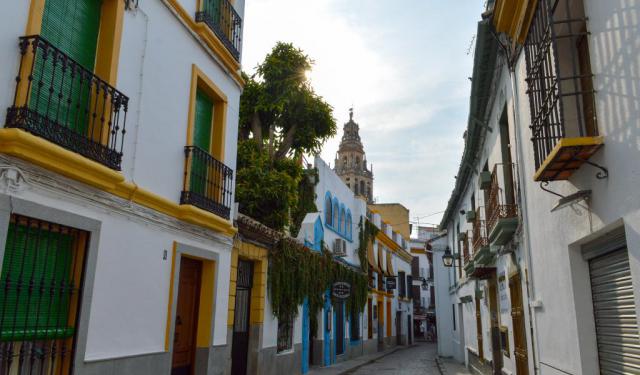
Mezquita Catedral de Cordoba (Mosque-Cathedral of Cordoba), Cordoba (must see)
Abd al-Rahman I, the founder of the Umayyad Arab dynasty that ruled the greater part of Iberia for nearly three centuries, was in flight from Abbasid rebels in 755. The Abbasids had overthrown the Umayyad regime in Syria and had killed most of his family. He saw political opportunities among the Muslim Arabs of the Iberian Peninsula. He came, he saw, and he conquered. Then he built the Great Mosque of Cordoba in 785 AD.
In the 9th and 10th centuries, the Mosque-Cathedral of Cordoba (Mezquita Catedral de Cordoba) became the largest structure in the Islamic world. The ground plan, 590 by 425 feet, covers as much ground as St Peter's in Rome. One-third of the area is the Courtyard of the Orange trees (Patio de los Naranjos), the site of ablutions before prayer. The 14th-century Gate of Forgiveness is next to the bell tower. The Mosque was expanded multiple times under Abd al-Rahman's successors up to the late 10th century.
The bell tower, built by Abd ar-Rahman III in 952, served as a minaret. The actual minaret was enclosed with a strengthening outer shell by Christians in the 16th and 17th centuries. Unlike other important mosques of the time, the Mosque-Cathedral of Cordoba was conceived as a plain horizontal space for prayer as an open yard in the desert.
Within the Mosque-Cathedral is a high, flat roof decorated in gold and colored motifs, supported by striped archways resting on a forest of 856 columns. In 1236 Cordoba fell to King Ferdinand III of Castile, and the religious structure became a Catholic cathedral. The Cathedral's first chapel, the Villaviciosa Chapel, was installed.
The Christian Era additions that came after 1236 up to the current time, included small chapels and some cosmetic alterations. The items added during the 16th century were the cruciform nave, the transept, and the Main Chapel. The columns in the hypostyle main hall were made of jasper, onyx, marble, granite, and porphyry.
Changes came in different styles: Gothic, Baroque, Mannerist, and Renaissance; all this with the Mudejar ornamentation and decoration accents of the original builders. The elliptical dome is sculpted with images of the four evangelists. There are representations of the Trinity, the Fathers of the Church, and images of David, Solomon, Daniel, and Samuel.
Nowadays, the Mosque-Cathedral of Cordoba is an important monument in the history of Islamic architecture and is also one of Spain's major historical monuments and tourist attractions, as well as a UNESCO World Heritage Site since 1984.
In the 9th and 10th centuries, the Mosque-Cathedral of Cordoba (Mezquita Catedral de Cordoba) became the largest structure in the Islamic world. The ground plan, 590 by 425 feet, covers as much ground as St Peter's in Rome. One-third of the area is the Courtyard of the Orange trees (Patio de los Naranjos), the site of ablutions before prayer. The 14th-century Gate of Forgiveness is next to the bell tower. The Mosque was expanded multiple times under Abd al-Rahman's successors up to the late 10th century.
The bell tower, built by Abd ar-Rahman III in 952, served as a minaret. The actual minaret was enclosed with a strengthening outer shell by Christians in the 16th and 17th centuries. Unlike other important mosques of the time, the Mosque-Cathedral of Cordoba was conceived as a plain horizontal space for prayer as an open yard in the desert.
Within the Mosque-Cathedral is a high, flat roof decorated in gold and colored motifs, supported by striped archways resting on a forest of 856 columns. In 1236 Cordoba fell to King Ferdinand III of Castile, and the religious structure became a Catholic cathedral. The Cathedral's first chapel, the Villaviciosa Chapel, was installed.
The Christian Era additions that came after 1236 up to the current time, included small chapels and some cosmetic alterations. The items added during the 16th century were the cruciform nave, the transept, and the Main Chapel. The columns in the hypostyle main hall were made of jasper, onyx, marble, granite, and porphyry.
Changes came in different styles: Gothic, Baroque, Mannerist, and Renaissance; all this with the Mudejar ornamentation and decoration accents of the original builders. The elliptical dome is sculpted with images of the four evangelists. There are representations of the Trinity, the Fathers of the Church, and images of David, Solomon, Daniel, and Samuel.
Nowadays, the Mosque-Cathedral of Cordoba is an important monument in the history of Islamic architecture and is also one of Spain's major historical monuments and tourist attractions, as well as a UNESCO World Heritage Site since 1984.
Want to visit this sight? Check out these Self-Guided Walking Tours in Cordoba. Alternatively, you can download the mobile app "GPSmyCity: Walks in 1K+ Cities" from Apple App Store or Google Play Store. The app turns your mobile device to a personal tour guide and it works offline, so no data plan is needed when traveling abroad.
Mezquita Catedral de Cordoba (Mosque-Cathedral of Cordoba) on Map
Sight Name: Mezquita Catedral de Cordoba (Mosque-Cathedral of Cordoba)
Sight Location: Cordoba, Spain (See walking tours in Cordoba)
Sight Type: Religious
Guide(s) Containing This Sight:
Sight Location: Cordoba, Spain (See walking tours in Cordoba)
Sight Type: Religious
Guide(s) Containing This Sight:
Walking Tours in Cordoba, Spain
Create Your Own Walk in Cordoba
Creating your own self-guided walk in Cordoba is easy and fun. Choose the city attractions that you want to see and a walk route map will be created just for you. You can even set your hotel as the start point of the walk.
Cordoba Introduction Walking Tour
It is said that the Carthaginian general, Hamilcar Barca, named the town Qart Juba which means "Town of Juba," for a comrade general killed in battle. Roman conquerors pronounced the name "Corduba." Close enough.
A Carthaginian settlement on the West Bank of the Guadalquivir River was captured by the Romans in 206 BC. A proper Roman colony was founded near the Iberian... view more
Tour Duration: 2 Hour(s)
Travel Distance: 3.3 Km or 2.1 Miles
A Carthaginian settlement on the West Bank of the Guadalquivir River was captured by the Romans in 206 BC. A proper Roman colony was founded near the Iberian... view more
Tour Duration: 2 Hour(s)
Travel Distance: 3.3 Km or 2.1 Miles
Ancient Roman Sites Walking Tour
Under all in Cordoba lies a once redoubtable Roman strongpoint. After Scipio's defeat of the Carthaginians in Llipa, the victorious Romans set up camp by the Guadalquivir River.
Under Augustus, the city gained the status of Colonia Patricia. A perimeter wall was built touching the Guadalquivir River. There were two forums, colonial and provincial. A large amphitheater has been uncovered.... view more
Tour Duration: 1 Hour(s)
Travel Distance: 2.5 Km or 1.6 Miles
Under Augustus, the city gained the status of Colonia Patricia. A perimeter wall was built touching the Guadalquivir River. There were two forums, colonial and provincial. A large amphitheater has been uncovered.... view more
Tour Duration: 1 Hour(s)
Travel Distance: 2.5 Km or 1.6 Miles
Cordoba Jewish Quarter Walk
The Judería de Córdoba is the area in Córdoba that was once densely populated by the Jews, between the 10th and the 15th centuries. Back then, it was a time when three world religions – Christianity, Judaism, and Islam – coexisted in Córdoba, although not always peacefully. Attesting to that today are the major religious shrines found in the area, like the Synagogue, the Mosque-Cathedral... view more
Tour Duration: 1 Hour(s)
Travel Distance: 0.4 Km or 0.2 Miles
Tour Duration: 1 Hour(s)
Travel Distance: 0.4 Km or 0.2 Miles



